Lalique Group Bundle
How Does Lalique Group Navigate the Cutthroat Luxury Market?
The luxury goods market is a high-stakes arena where heritage, craftsmanship, and brand allure reign supreme. Lalique Group SWOT Analysis reveals how this iconic brand, born in 1888, has evolved from a glassmaking pioneer into a diversified luxury powerhouse. This article dives deep into the competitive landscape, exploring the strategies that have allowed Lalique Group to thrive amidst intense market rivalries.
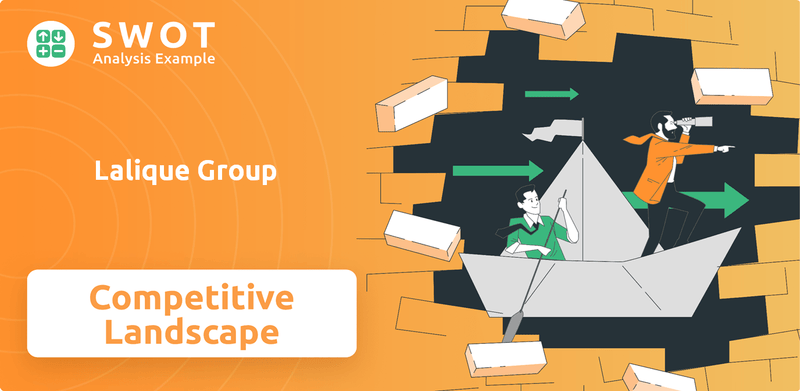
Understanding the competitive landscape of the Lalique company is crucial for investors and industry observers alike. This market analysis will dissect Lalique Group's position, examining its key competitors and competitive advantages within the luxury goods market. We'll explore how Lalique Group's market strategy and brand positioning contribute to its success, and how it addresses the challenges and opportunities that shape its future in the industry.
Where Does Lalique Group’ Stand in the Current Market?
The Lalique Group holds a specialized position within the luxury goods market, focusing on high-end crystal, fragrances, decorative objects, and luxury hospitality. While specific market share figures are often proprietary, the company is recognized as a leader in prestige crystalware and has a significant presence in artistic perfumery. Its core operations revolve around the design, production, and distribution of luxury products, with a strong emphasis on craftsmanship and artistic collaboration.
The value proposition of the Lalique Group centers on offering exclusive, high-quality products that appeal to discerning collectors and high-net-worth individuals. The group's brands, including Lalique crystal and Lalique Parfums, are synonymous with luxury, artistry, and heritage. The company strategically reinforces its ultra-premium image through bespoke and limited-edition offerings, ensuring its products remain highly desirable in the competitive landscape.
The company's financial performance in 2023 demonstrates its solid market position. Consolidated gross sales grew by 6.7% to EUR 179.6 million, and operating profit increased by 13.9% to EUR 14.8 million. This growth, especially in its core crystal and fragrance segments, underscores the effectiveness of its market strategy and its ability to compete within the luxury goods market. For more insight into the company's origins, you can read a Brief History of Lalique Group.
Lalique Group has a strong presence in Europe, with a particular focus on France and Switzerland. It also has a significant global reach through boutiques, department store concessions, and duty-free channels. The company is expanding its presence in key luxury markets, including Asia and North America.
The product portfolio includes Lalique crystal (decorative items, art pieces), Lalique Parfums (fragrances and cosmetics), and other luxury brands such as Jaguar Fragrances and Bentley Fragrances. The group also operates in the hospitality sector, with properties like Villa René Lalique.
Lalique Group focuses on an ultra-premium image, emphasizing craftsmanship, artistic collaboration, and exclusive distribution. The company's move towards bespoke and limited-edition offerings caters to discerning collectors and high-net-worth individuals, solidifying its brand positioning within the luxury goods market.
The company's financial health is robust, with consolidated gross sales increasing to EUR 179.6 million in 2023. Operating profit also saw a significant increase, reaching EUR 14.8 million. Strong performance in core segments like crystal and fragrances drives growth.
Lalique Group's competitive advantages include its strong brand reputation, high-quality products, and strategic market positioning. The company's focus on craftsmanship and artistic collaborations creates a unique appeal in the luxury goods market.
- Strong Brand Heritage: A long-standing reputation for quality and artistry.
- Exclusive Products: Limited editions and bespoke offerings cater to high-net-worth individuals.
- Strategic Distribution: A global network of boutiques and partnerships.
- Financial Strength: Consistent revenue and profit growth.
Lalique Group SWOT Analysis
- Complete SWOT Breakdown
- Fully Customizable
- Editable in Excel & Word
- Professional Formatting
- Investor-Ready Format
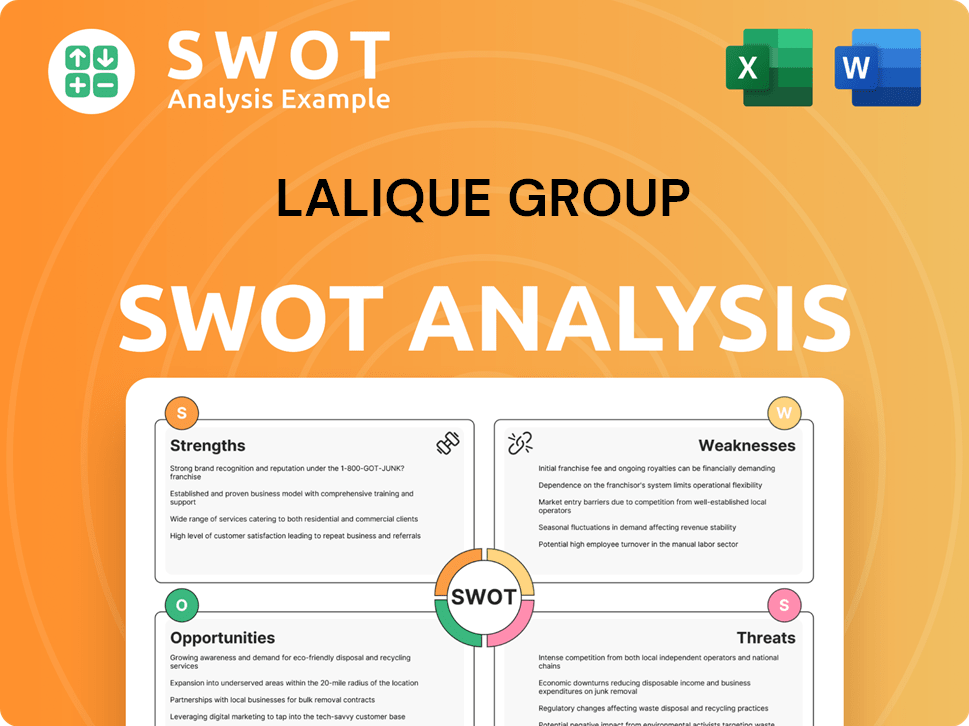
Who Are the Main Competitors Challenging Lalique Group?
The competitive landscape for the Lalique Group is multifaceted, spanning several luxury segments. This analysis of the competitive landscape considers the company's position in crystal, fragrance, cosmetics, and hospitality sectors. Understanding the direct and indirect competitors is crucial for assessing the Lalique Group's market position and strategic challenges.
The company faces competition from established luxury brands and niche players. Market analysis of the Lalique company reveals a dynamic environment where brand recognition, product innovation, and distribution are key factors. The luxury goods market is characterized by high barriers to entry and intense competition, requiring continuous adaptation to consumer preferences and market trends.
In the crystal and decorative arts sector, the primary competitors include brands like Baccarat, Daum, and Steuben. These companies compete on heritage, craftsmanship, and artistic collaborations. For instance, Baccarat's extensive product range, including crystal lighting and tableware, targets a similar affluent clientele. Daum offers unique pâte de verre pieces, presenting a distinct aesthetic challenge to Lalique Group.
In the fragrance and cosmetics arena, Lalique Parfums competes with a wide array of prestige and niche fragrance houses. These competitors include established luxury brands and niche perfumers.
Direct competitors include Chanel, Dior, Hermès, Creed, Byredo, and Frederic Malle. They compete on brand recognition, product innovation, marketing spend, and distribution reach.
The automotive fragrance licenses (Jaguar and Bentley) place Lalique Group in competition with other luxury brands that license their names for fragrances, such as Mercedes-Benz Parfums.
Villa René Lalique and Château Hochberg compete with luxury boutique hotels and Michelin-starred restaurants. This competition is based on unique experiences, culinary excellence, and exclusive ambiance.
Emerging players in the broader luxury market, particularly those leveraging e-commerce and direct-to-consumer models, also present a disruptive element, pushing traditional luxury brands to adapt their strategies.
Mergers and alliances, such as LVMH's continuous acquisitions, reshape the competitive landscape by consolidating power and resources among luxury conglomerates.
The competitive landscape for Lalique Group is shaped by several factors. Understanding these dynamics is essential for strategic planning and market positioning.
- Brand Recognition: Established brands like Chanel and Dior have significant market visibility.
- Product Innovation: Niche perfumers like Creed and Byredo focus on unique fragrance profiles.
- Distribution Reach: Wide distribution networks are crucial for market penetration.
- Marketing Spend: Extensive marketing campaigns impact consumer mindshare.
- E-commerce: The rise of e-commerce and direct-to-consumer models is disrupting traditional luxury brands.
Lalique Group PESTLE Analysis
- Covers All 6 PESTLE Categories
- No Research Needed – Save Hours of Work
- Built by Experts, Trusted by Consultants
- Instant Download, Ready to Use
- 100% Editable, Fully Customizable
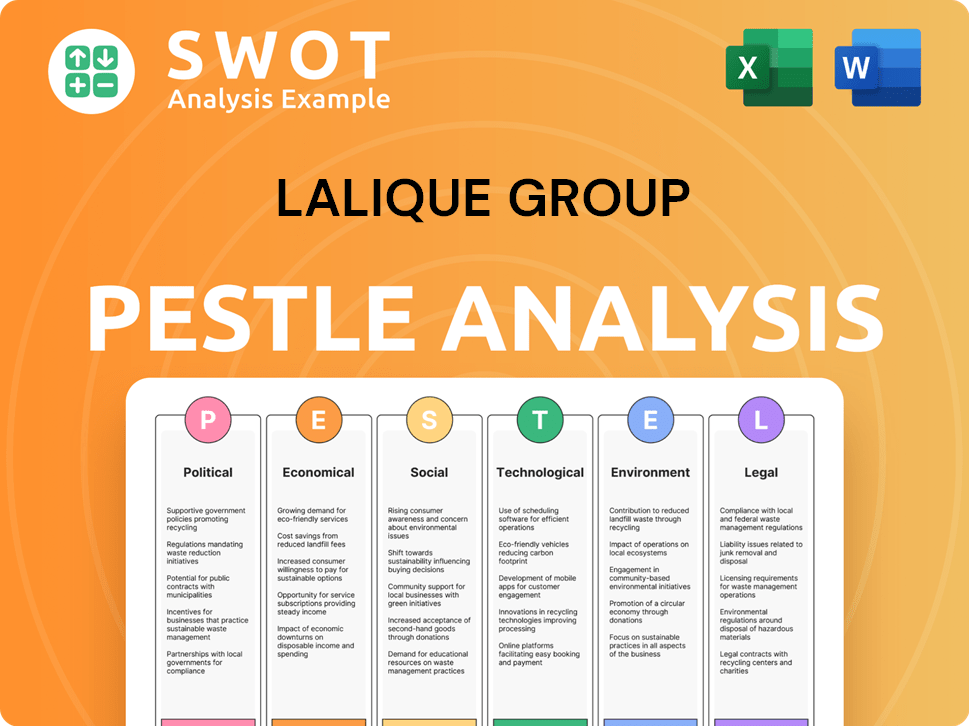
What Gives Lalique Group a Competitive Edge Over Its Rivals?
The Lalique Group's competitive advantages are deeply rooted in its heritage, craftsmanship, and brand equity. The brand, with a history spanning over a century, embodies artistic innovation and design excellence. This legacy fuels strong brand recognition and customer loyalty, allowing the company to command premium pricing within the luxury goods market.
Its proprietary expertise in crystal making, particularly the unique 'satin finish' technique, sets its products apart, creating a significant barrier to entry for competitors. This specialized manufacturing know-how and intellectual property are crucial. The company's diversified portfolio, spanning crystal, fragrance, and hospitality, further strengthens its position. Strategic collaborations with renowned artists and designers help refresh product offerings, maintaining artistic integrity.
The Lalique company benefits from a global distribution network, including its own boutiques, high-end department stores, and duty-free channels, ensuring brand visibility in key luxury hubs. These advantages have evolved from the company's commitment to art and design, yet face challenges from evolving consumer preferences and the rise of digital-native luxury brands. For a deeper understanding of the company's ownership structure, you can explore Owners & Shareholders of Lalique Group.
The Lalique Group leverages its rich history and artistic legacy to foster strong brand recognition. This allows the company to maintain a premium pricing strategy. Its long-standing reputation enhances customer loyalty and brand equity within the competitive landscape.
Unique techniques, like the 'satin finish', provide a competitive edge. This expertise creates a significant barrier to entry for rivals. The specialized manufacturing know-how is a key differentiator in the luxury goods market.
The company's diverse offerings across crystal, fragrance, and hospitality create synergistic opportunities. This diversification reduces reliance on a single product category. Cross-promotion, such as between crystalware and hotels, enhances brand visibility.
A robust global distribution network ensures broad market access and brand visibility. This includes boutiques, high-end department stores, and duty-free channels. The extensive reach supports sales and reinforces the brand's presence in key luxury hubs.
The primary competitive advantages of the Lalique Group include brand heritage, proprietary craftsmanship, a diversified product portfolio, and a global distribution network. These elements contribute to the company's strong market position and ability to command premium pricing. The company's strategic collaborations and commitment to innovation also support its long-term growth.
- Strong Brand Equity: A century-old legacy of artistic innovation.
- Proprietary Techniques: Unique crystal-making processes.
- Diversified Portfolio: Spanning crystal, fragrance, and hospitality.
- Global Distribution: Extensive network in key luxury markets.
Lalique Group Business Model Canvas
- Complete 9-Block Business Model Canvas
- Effortlessly Communicate Your Business Strategy
- Investor-Ready BMC Format
- 100% Editable and Customizable
- Clear and Structured Layout
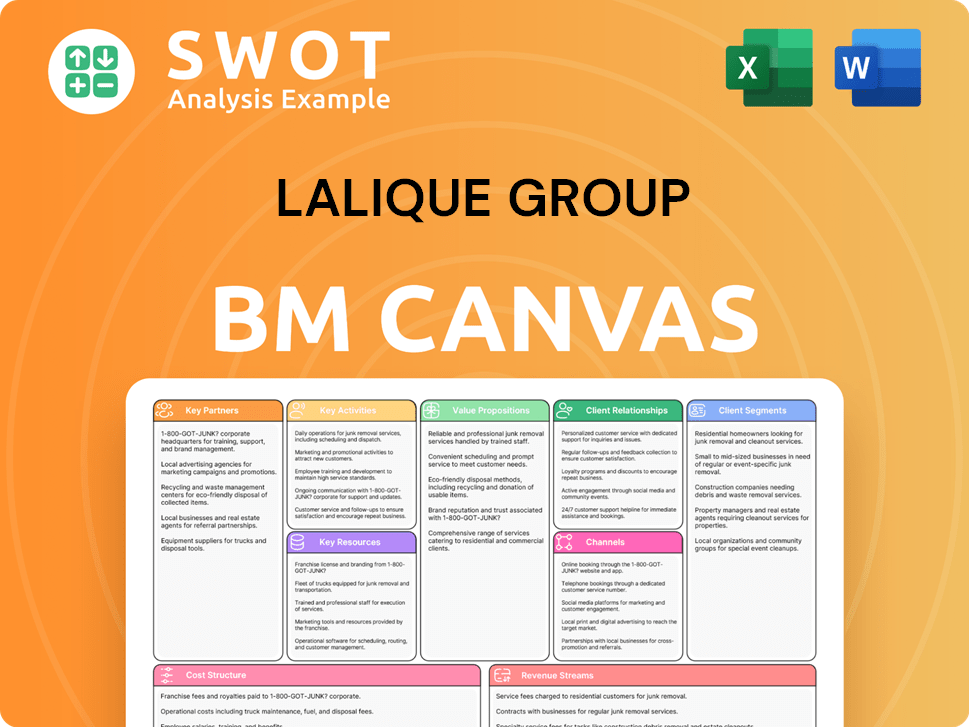
What Industry Trends Are Reshaping Lalique Group’s Competitive Landscape?
The Lalique Group's competitive landscape is significantly shaped by the dynamic luxury goods market. A thorough market analysis reveals that the company faces both challenges and opportunities stemming from evolving industry trends. Understanding these factors is crucial for evaluating the Lalique company's future outlook and strategic positioning.
The luxury industry is undergoing a period of transformation, with digital advancements, sustainability concerns, and the demand for personalized experiences reshaping consumer behavior. These trends present both risks and potential rewards for Lalique Group, influencing its market strategy and ability to compete with established industry rivals.
Digital transformation and e-commerce are redefining how luxury goods are marketed and sold. Sustainability and ethical sourcing are increasingly important to luxury consumers. The growing demand for personalized and experiential luxury is another key trend.
Economic downturns can impact discretionary spending on luxury items. Increased regulatory scrutiny on product origins and environmental impact. Aggressive expansion by large luxury conglomerates and the rise of the resale market.
Emerging luxury markets, particularly in Asia, present significant growth opportunities. Product innovation, especially in sustainable materials and smart luxury items, offers avenues for growth. Strategic partnerships can unlock new product categories or distribution channels.
Greater emphasis on digital engagement, sustainable practices, and the integration of its diverse luxury offerings. Aiming to create a holistic brand experience to remain resilient. Capitalizing on the growing global luxury market.
The Lalique Group faces a complex competitive environment. Its ability to adapt to these changes will determine its success. The company's market strategy must address both current challenges and future opportunities within the luxury goods sector.
- The global luxury goods market was valued at approximately $345 billion in 2023, with projections indicating continued growth, particularly in Asia.
- Digital sales in the luxury sector are increasing, with e-commerce accounting for roughly 25% of total luxury sales in 2024.
- Sustainability is a key focus, with over 70% of luxury consumers expressing a preference for brands with strong environmental and social responsibility practices.
- The resale market for luxury goods is expanding, estimated to reach $85 billion by 2025, influencing new product sales.
Lalique Group Porter's Five Forces Analysis
- Covers All 5 Competitive Forces in Detail
- Structured for Consultants, Students, and Founders
- 100% Editable in Microsoft Word & Excel
- Instant Digital Download – Use Immediately
- Compatible with Mac & PC – Fully Unlocked
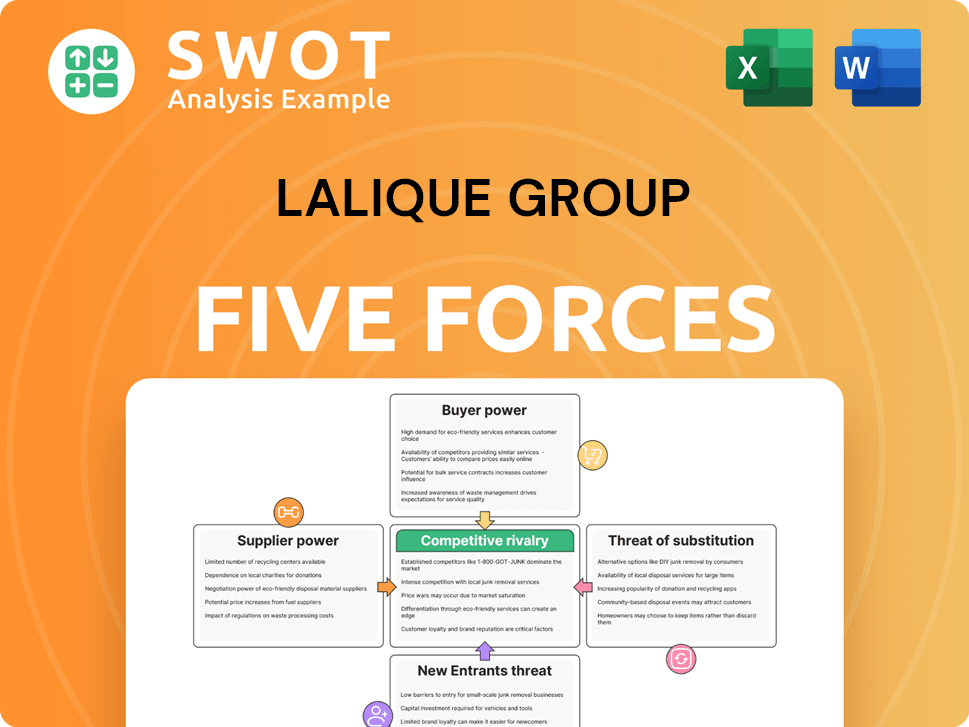
Related Blogs
- What are Mission Vision & Core Values of Lalique Group Company?
- What is Growth Strategy and Future Prospects of Lalique Group Company?
- How Does Lalique Group Company Work?
- What is Sales and Marketing Strategy of Lalique Group Company?
- What is Brief History of Lalique Group Company?
- Who Owns Lalique Group Company?
- What is Customer Demographics and Target Market of Lalique Group Company?
Disclaimer
All information, articles, and product details provided on this website are for general informational and educational purposes only. We do not claim any ownership over, nor do we intend to infringe upon, any trademarks, copyrights, logos, brand names, or other intellectual property mentioned or depicted on this site. Such intellectual property remains the property of its respective owners, and any references here are made solely for identification or informational purposes, without implying any affiliation, endorsement, or partnership.
We make no representations or warranties, express or implied, regarding the accuracy, completeness, or suitability of any content or products presented. Nothing on this website should be construed as legal, tax, investment, financial, medical, or other professional advice. In addition, no part of this site—including articles or product references—constitutes a solicitation, recommendation, endorsement, advertisement, or offer to buy or sell any securities, franchises, or other financial instruments, particularly in jurisdictions where such activity would be unlawful.
All content is of a general nature and may not address the specific circumstances of any individual or entity. It is not a substitute for professional advice or services. Any actions you take based on the information provided here are strictly at your own risk. You accept full responsibility for any decisions or outcomes arising from your use of this website and agree to release us from any liability in connection with your use of, or reliance upon, the content or products found herein.